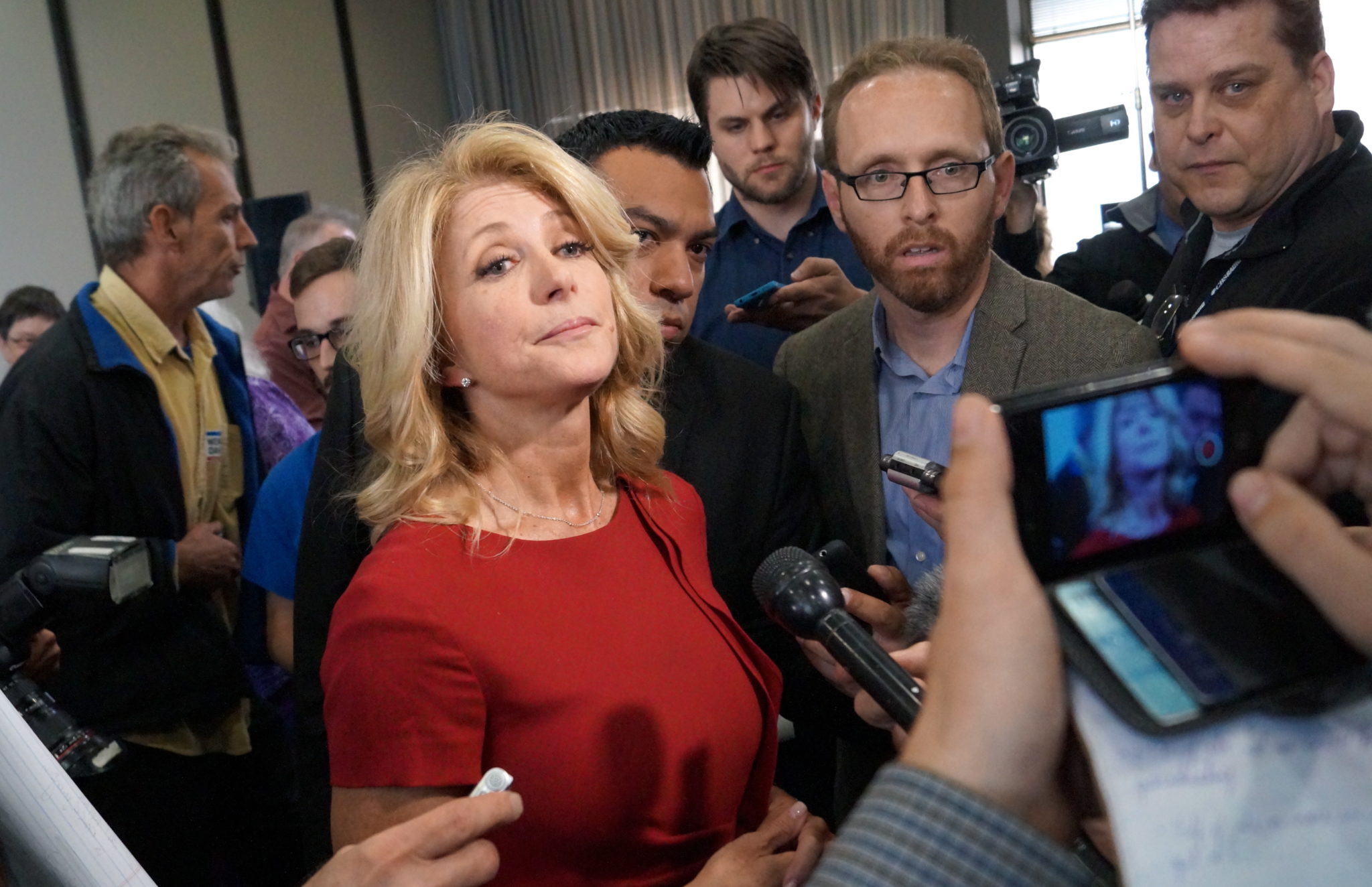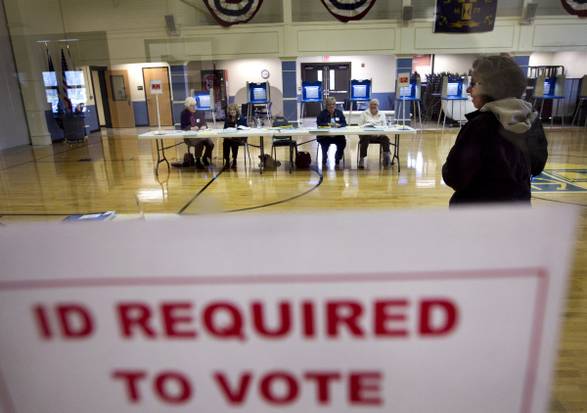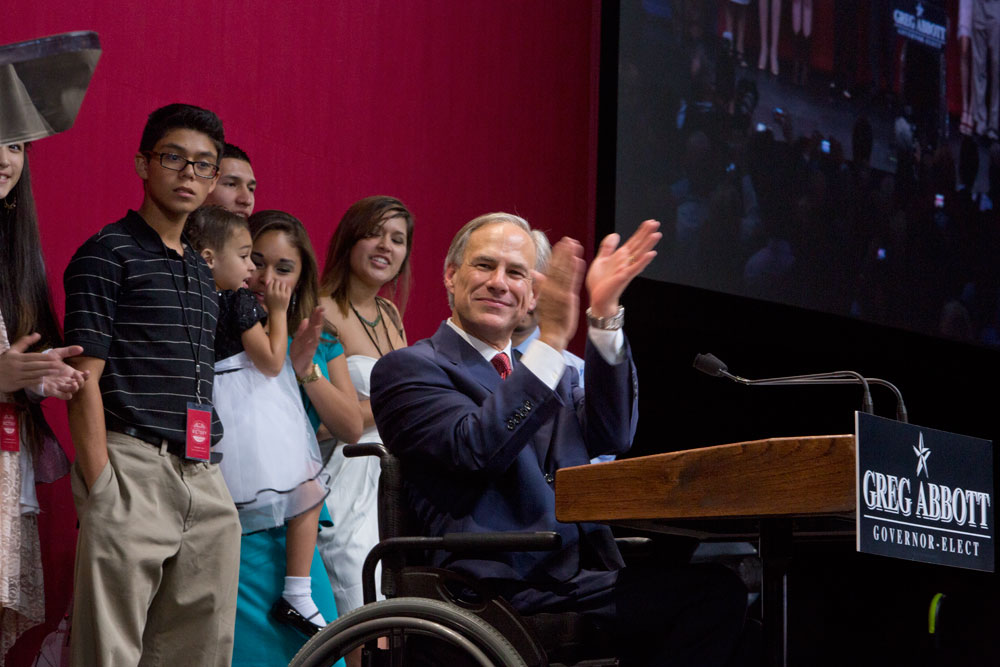
Something’s Missing from Wendy Davis Ads—Wendy Davis

Above: Wendy Davis speaks to the press at an election rally, April 14, 2014.
There’s something weird about the Wendy Davis campaign’s recent ads. Have you seen them? If not, you probably will soon.
We’re at the stage of the campaign where candidates start to open their coffers. This is the most expensive race in Texas history, and at the top of the ticket, Davis has amassed a small fortune, which is absolutely dwarfed by the Abbott’s much larger fortune. These campaigns are set to run a formidable air war against each other come the fall, and it’s starting. But Abbott’s cash advantage—he had $35.6 million to Davis’ $11.1 million mid-summer—means he can run pretty much whatever he wants, when he wants. Abbott has ads running in movie theaters, for Christ’s sake.
Davis needs to be more selective. What the campaign can’t do in quantity, it needs to achieve with quality. So her first ads are an interesting reflection of the campaign’s priorities and direction as we close in on the election.
Her first ad, which dropped earlier this month, is called “A Texas Story.” That sounds promising, right? Davis has an incredible personal story: Remarkable individual achievement and perseverance, coming from a highly disadvantaged background. Her story, you could say, is the state’s story writ small. There’s so much most voters still don’t know about who she is. This could make a great ad.
Of course, “A Texas Story” wasn’t about Davis: It was about a “young mother” getting “brutally raped” while “her children slept in the very next room.” Those quotes are from the Davis campaign’s own copy. It’s one of the most disturbing campaign ads you’ll ever see: It makes the Willie Horton ad look like a documentary about a cupcake factory (albeit, a racist one.) It’s the only campaign ad I’ve ever seen that needs a trigger warning.
It’s an extremely slick and exploitative video. It feels like it was pulled from one of the more sordid true crime shows that populate basic cable. A carefully placed upturned tricycle, near the end, signals the lost innocence of the “brutally raped” woman’s children.
About 45 seconds into the ad, we get to the point: The rapist was a door-to-door salesman for a vacuum cleaner company, and the woman sued that company. When Abbott was a Texas Supreme Court Justice, he heard the case and opined that the company didn’t owe damages. He was in the minority.
There’s a lot of weird things about the ad, like the fact that Abbott doesn’t appear until the end. The worst thing might be that the Davis campaign, when asked the obvious question, didn’t seem to know whether they had told the “brutally raped” “young mother” that her story would be on TV, inviting a flood of scrutiny. Southern Methodist University political scientist Cal Jillson, who’s the closest thing we have to a referee on these sorts of things, told the Houston Chronicle that if the campaign hadn’t informed the woman, they were at “moral and political fault.”
But that’s not the weird thing I was thinking of at the top of this piece. The rape-y ad was from earlier this month—here’s a more recent one:
In it, Manuel Alvarado, a cancer survivor from Fort Worth, bemoans the failure of CPRIT and ties its failures to Greg Abbott. It’s a much more conventional political attack ad.
Here’s the thing: Where’s Wendy? Does this look to anyone like the kind of campaign people thought Davis was going to be running when she jumped in the race last year?
A caveat: I don’t know how to run campaigns. Bill White ran a bunch of positive ads in 2010 and lost. Maybe these are really, really smart ads. Maybe they’re effective on apathetic, low-information voters, and maybe they’ve tested alternatives and come to the conclusion that this is the best option.
But think about what Democrats were most excited about after Davis filibustered, and declared her candidacy. They were excited to have a Candidate. Bill White and Chris Bell were nice fellows who were OK candidates and probably would have been good governors, but they weren’t Candidates. Davis was a Candidate.
She had massive star power among the Democratic base, and she had a unbelievably impressive biography. She could draw big money from out-of-state liberals. She represented a seemingly center-right district and held it as a Democrat in two rough cycles. Suburban Republican women loved her. Through the strength of her personality and sheer force of will, she would make this a fight. Whatever it was, she had it.
So where is it?
A recent Rasmussen poll had Abbott’s favorability numbers dipping, so maybe the attack lines are working. But Davis’ favorability numbers have been a problem the whole campaign—one PPP poll from April had her unfavorability rating at 47 percent. (Abbott’s was 27 percent.) A lot of voters don’t seem to know much about her, and she has trouble with the ones that do.
There’s a little over two months left, which, in politics, is both an eon and not very much time at all. Can the Davis that Democrats were excited about last year break through the smooth machining of a consultant-driven, attack ad-heavy campaign?
As a coda, consider two other videos. Leticia Van de Putte’s campaign hasn’t had enough money to participate in the ad war yet, but it will at some point. But here’s a video her campaign put together to use as an intro at the Democratic convention in June. It’s a bit corny at points, but it’s humanizing and warm and funny, and it’s hard not to come away from it liking Van de Putte more. It’s the polar opposite of “A Texas Story.”
And here’s one of the zillions of web ads that Greg Abbott has produced—here’s, effectively, what “A Texas Story” stands in opposition to. Consider that Abbott, frankly speaking, is not a charismatic guy, or a particularly talented politician. Watch how effectively the ad masks that:
Look at that smiling, happy man. Look at the pretty boats and sky and fish, and how hard those guys are working. Listen to how he’ll fight for you. Don’t you want him to be your governor?


